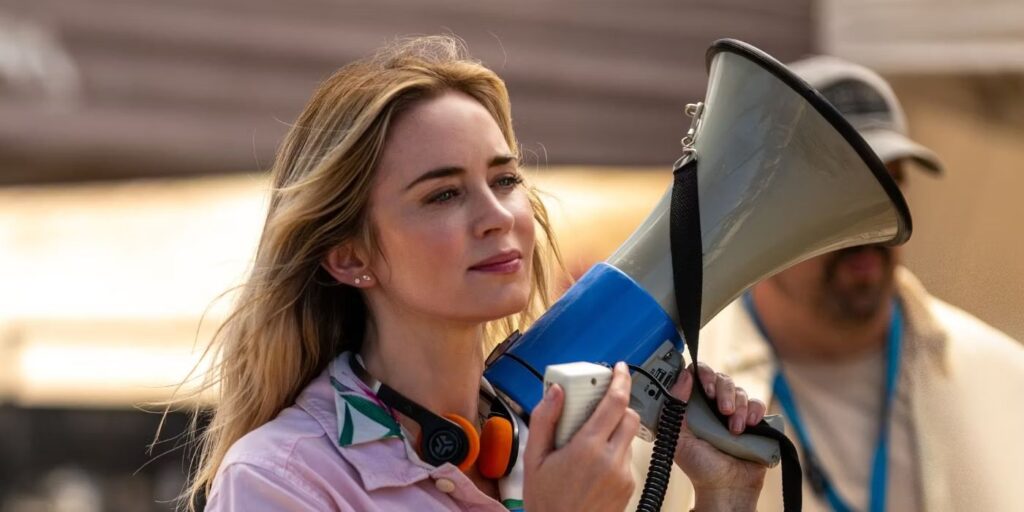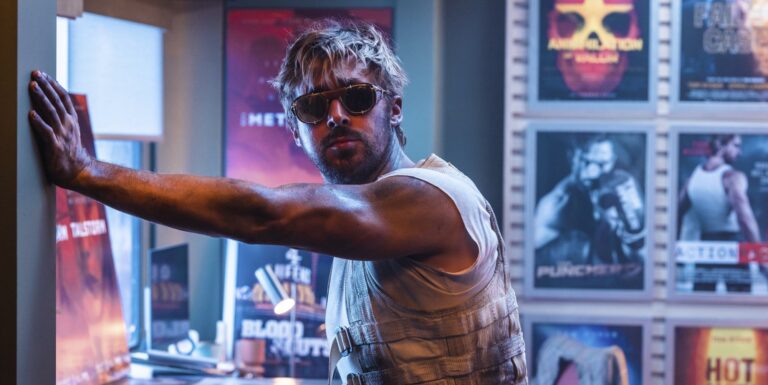Films about filmmaking are often at their best when championing the process while simultaneously poking fun at the inherent absurdity of the Hollywood machine. Case in point: The Fall Guy, David Leitch’s love letter to the oft underappreciated stunt performers without whom our favorite blockbusters wouldn’t be possible. A former stuntman himself, Leitch’s filmography (which includes the John Wick series) is rife with jaw-dropping stunts and “how did they do that” moments, and he brings the same flair to this charming, self-aware comedy.
A loose reimagining of the popular 1980s television series starring Lee Majors, The Fall Guy centers on Colt Seavers (Ryan Gosling), a veteran Hollywood stuntman whose career is sidelined after an on-set accident leaves him with a broken back. His romance with camera operator Jody Moreno (Emily Blunt) is another unfortunate casualty, but nearly two years later, Colt finds himself with a second chance: Jody is on the verge of her big break, directing a massive sci-fi tentpole called MetalStorm — the kind of genre fare that debuts footage in San Diego Comic Con’s legendary Hall H — and producer Gail (Hannah Waddington) persuades Colt to resume his longstanding gig as stunt double for the leading man, action superstar Tom Ryder (Aaron Taylor-Johnson).
Of course, Gail’s enthusiastic pitch to Colt (wherein she insists that Jody asked for him specifically) doesn’t exactly jive with the reality of the situation; nor does she mention that Tom has been missing from production for several days and MetalStorm is on the brink of shutdown thanks to its ballooning budget. But whatever: Colt is just happy to be near Jody again, even as she forces him to undergo take after take of being set on fire and thrown into a wall; she clearly has some unresolved anger about their breakup.

While the mystery of Tom’s disappearance is certainly a major narrative factor, The Fall Guy positions the romance as the driving force that propels the film forward. Gosling and Blunt have wonderful onscreen chemistry, which makes it easy to buy into the notion that nearly every ill-advised decision Colt makes is in service of helping Jody achieve her dream. If tracking down a missing cell phone with incriminating video footage or duking it out with sinister thugs during a wild crosstown chase — hilariously intercut with a furious Jody belting out the lyrics to Phil Collins’ “Against All Odds (Take a Look at Me Now)” at a karaoke party — also affords Colt the opportunity to set things right between them, that’s just icing on the cake.
As one might expect from Leitch, the stuntwork on display in The Fall Guy is top notch, undeniably thrilling despite often being played for comedic effect. Leitch also demystifies, to a certain extent, the complexities of managing a sprawling tentpole picture and working with multiple units, and we see firsthand just how integral the stunt team can be to the entire filmmaking process. There’s a joke about stunt performers rarely enjoying the same kind of accolades as other creatives — no Oscars for people that get thrown off buildings or survive elaborate car crashes — but the humor seems to barely mask Leitch and his team’s genuine feelings: these people deserve to be recognized and acknowledged for their contributions, and the fact that it happens so rarely is a point of frustration.
Ultimately, The Fall Guy might not change the industry’s treatment of stunt performers, but it highlights their work in a way that few major films — especially the sort of films that serve as the opening salvo of the summer movie season — have done before, and that’s worthy of respect in and of itself. But it’s also a genuine delight, balancing the earnestness of a romantic comedy with major setpieces that action lovers will appreciate, and knowing precisely when to dial up the cheese or give a sly wink to the audience.

